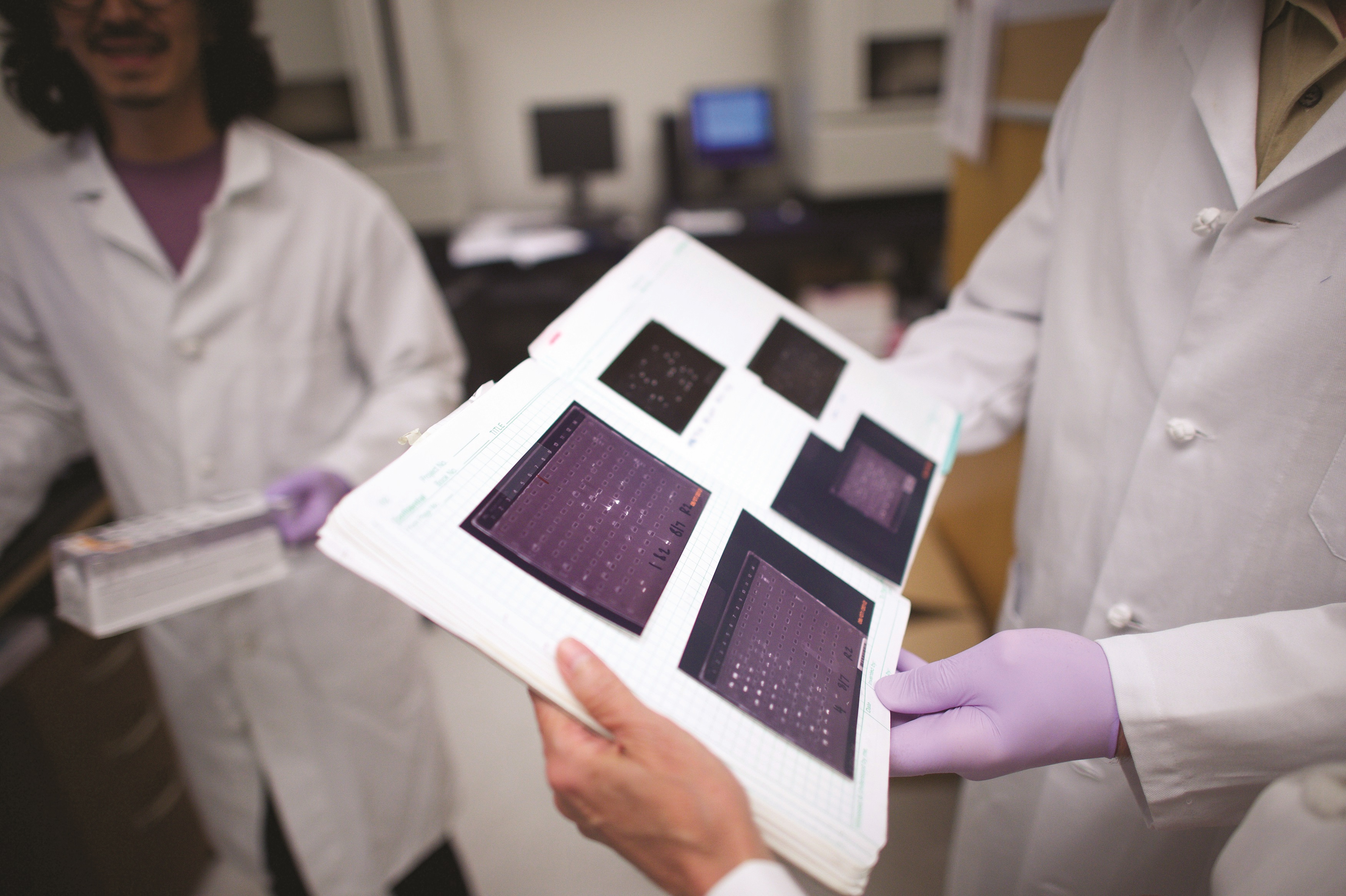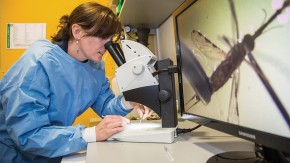George Shaw with his wife Beatrice Hahn in the lab, where they have been studying HIV.
MOLECULAR ANALYSIS AND MODELING OF HIV-1 TRANSMISSION, CONTAINMENT AND ESCAPE
- Jan 1, 2016
- Download Retrospective

Analyzing gene sequences from different HIV samples.
George Shaw, University of Alabama at Birmingham, United States
Creating a vaccine that can protect against HIV, the AIDS virus, is one of the greatest challenges facing modern scientists. A principal stumbling block has been that once inside the body HIV replicates into swarms of mutated versions that escape the best efforts of the immune system to identify a target to attack effectively.
In 2008, George Shaw, a veteran AIDS scientist, helped uncover a possible solution. The blood of an individual with a long-term, or chronic, infection contains billions of genetically diverse copies of HIV. In a discovery widely hailed by the AIDS research field, Shaw and a team of researchers from 13 academic and government laboratories found that often only one virus particle from a chronically infected individual is transmitted to a recipient in an initial infection through a sexual contact.[1] The finding may indicate an Achilles' heel that a vaccine might exploit.
"It has provided a really important conceptual understanding of what happens at the initial transmission and it's helping inform our efforts for new vaccines," says Anthony Fauci, director of the U.S. National Institute of Allergy and Infectious Disease (NIAID).
The large research collaboration, which began in 2005 and was funded by both the Bill & Melinda Gates Foundation and the NIAID, found that this single "transmitted/founder" (T/F) virus has a consistent set of biological characteristics that may provide vaccine makers with a clearer picture of what kind of vaccine could someday work. The researchers found that in 76 percent of a group of 102 HIV-infected individuals, just one virus particle, or virion, makes it past the body's initial immune defenses.[1] It is at this point HIV may be most vulnerable if scientists can determine how a vaccine can stimulate antibodies against it.
"Before this, the transmission event was largely a black box," says Shaw. "What we did was to provide clear visibility on one of the most crucial elements of the viral life cycle, one that is central to the vaccine effort." Shaw says this was accomplished "by developing a novel experimental strategy combined with mathematical modeling of early viral replication dynamics that enabled a precise and unambiguous molecular identification of the HIV genome (or genomes) that crosses the mucosal barrier and establishes a productive clinical infection." This was a watershed moment, because the discovery of T/F viral genomes represented an enabling technology. Immediate applications to the global vaccine effort included the ability to molecularly clone genes of T/F viruses thereby capturing their precise genetic and biological make-up for further study,[2] the ability to trace with molecular precision the initial immune responses to the incoming virus,[3], [4] and the ability to detect the sieving effect of vaccine-elicited immune responses on HIV and SIV transmission.[5], [6]

Ever since HIV was identified as the causative agent of AIDS in 1984, researchers have tried classical vaccine approaches designed to trigger antibodies and white blood cells involved in the immune system to sweep out of the body an initial viral invasion before it can take hold. These traditional vaccines were comprised of weakened or killed versions of a virus or individual viral proteins that usually sit on a virus' outer envelope. Some of these envelope proteins are used by the virus to latch onto target cells. Once attached, the virus releases its contents into the cell and uses the invaded cell's genetic machinery in the nucleus like a factory to mass-produce more copies of itself. As the process is repeated over and over, the infection takes hold. In the case of HIV, the virus lays siege to T cells, white blood cells that play a critical role in fending off an infection. In the process of colonizing the T cells for its own purpose, HIV kills the cells. In this way, over time HIV cripples the body's ability to fight off the virus and other infections.
As a result, researchers want a vaccine that creates so-called neutralizing antibodies that are circulating in the blood prior to an infection. However, over time researchers realized that the HIV viral envelope antigens they were using to prime the immune system were stimulating the production of the wrong kind of antibodies that neutralized laboratory strains of the virus but not those circulating in nature. Getting a clear picture of the viruses that circulate in nature and that are transmitted from one person to the next is what the identification of T/F viruses allows.
By the early part of the new century, Shaw, at the time at the University of Alabama-Birmingham (UAB), had reached the conclusion of many HIV vaccine scientists. "For 25 years we had tried a lot of different approaches and they had all failed," he recalls thinking while sitting in his office at University of Pennsylvania, where he moved his laboratory in 2011. "Researchers felt we needed more information about the molecular makeup of the virus at the point of transmission, where a vaccine might be most effective."
In 2004, Shaw brought together researchers from seven other academic and government institutions to illuminate the biology of HIV when it first enters the body. The idea was to determine if the transmitted virus differed from HIV that was circulating in someone with a long-term chronic infection, and to determine how the human immune system responded to this virus in its generally futile attempt to control it. The collaboration won a five-year, $16.3 million grant beginning in 2005 from the Bill & Melinda Gates Foundation's Grand Challenges in Global Health program to produce a "molecular analysis and modeling of HIV-1 transmission."
"The funding was a godsend to us," says Shaw. He had wanted to undertake such a project but knew the research was going to be expensive, far beyond what the U.S. National Institutes of Health typically hands out to individual investigators. The project would have to support part of the high costs for recruiting a specialized group of infected and high-risk test subjects, or cohorts, to join the studies and have their blood examined. The researchers would need to find couples in which one person in the relationship was recently infected by the other. Samples from the two would allow researchers to identify the difference between the biology of HIV in a chronic infection, and HIV in a recent, or acute, infection. The best location to find these couples was in Africa, meaning that satellite labs and offices also would need to be funded. Fortunately for Shaw, he was able to recruit his former UAB colleagues Drs. Eric Hunter and Susan Allen to the effort. They had moved to Emory University and had established a network of HIV discordant couples and acutely infected individuals in Zambia and Rwanda.
Six months into the project, the research received additional support when Shaw's lab, which included his wife Beatrice Hahn, herself an esteemed AIDS scientist, was asked to join an even larger initiative led by Dr. Bart Haynes at Duke University and backed with $300 million for seven years by the NIAID.[7] The project, called the Center for HIV/AIDS Vaccine Immunology (CHAVI), funded six academic centers including Shaw's laboratory to study what happens in the earliest stages of HIV infection with a particular focus on early immune responses. Much of Shaw's Gates Grand Challenges work was focused on HIV-1 subtypes A and C in Zambia and Rwanda, whereas CHAVI targeted additional HIV-1 subtypes in South Africa, Malawi, Uganda, Europe and the United States.
"Scientists know little about these (HIV transmission) events because identifying individuals at the earliest stages of infection has been extremely difficult," an NIAID press release said at the time. As a result, Shaw became part of two separate collaborations with complementary goals.
For Shaw, the two groups working in parallel provided "important shared resources" as well as "some healthy competition." Shaw says the two groups shared findings but pursued their research separately, with different areas of focus that included transmitted virus biology and genetics and early host T cell and B cell responses. Each group engaged an increasing list of scientific collaborators as the implications of identifying actual T /F virus genomes became more widely appreciated. "I don't believe we and our many collaborators could have accomplished the research that was done and in such a rapid time frame with support from the Gates Foundation or the NIAID alone," says Shaw.
This early evidence strongly suggested to Shaw and Hunter that the transmitted viruses might be different from most viruses in chronically infected subjects.
At the time, says Shaw, scientists knew little about the genetic makeup of viruses that first gain entry into the body. "We knew that virus from chronically infected people was genetically very diverse as a result of all the mutations it underwent, and we knew the virus that was first transmitted during an acute infection was much less heterogeneous," he says. Researchers also knew that most strains of the virus that replicate soon after infection target certain cell types and enter those cells through a specific receptor on their surface. But the precise structure and functional properties of the virus envelope at the initial moment of transmission and in the first hours and days that follow, ultimately leading to a clinical infection, were unknown.
For years, HIV researchers wrestled with a concept called a population bottleneck, in which only a limited number of the virus' many genetic variants circulating in the blood of a person with a chronic infection are transmitted to a recipient. Studies had found that if, for example, 1,000 infected men were to have intercourse with an equal number of uninfected women, only one or two of the females might be expected to become infected from vaginal intercourse. Shaw says understanding the biological makeup and behavior of the few virus variants hardy enough to get past the bottleneck is critical.
The idea that the viruses that broke through the mucosa have certain shared properties that distinguished them from later variants was strengthened by some earlier research. The early-transmitted variants, for instance, all appeared to enter and infect T cells by binding first to the CD4 molecule, its primary receptor, and then to a coreceptor protein called CCR5. Indirect evidence supporting this came when researchers identified a small number of individuals who didn't become infected or sick even after multiple exposures to HIV. These "protected" individuals, it turned out, contained defective forms of the CCR5 coreceptor, as if the doorway into T cells in these individuals was jammed shut. Clearly, an infection required the virus to use an intact form of the receptor. As evidence like this mounted, scientists surmised that the outer envelope of the transmitted viral variants likely had a common physical profile that enabled them to pass through the CCR5 entryway.
But it was not clear if the transmitted virus must possess this feature, or if many viruses with different envelope properties might be passed from one individual to another, with those viruses that use CCR5 efficiently having an early growth advantage and outcompeting others, at least initially. Researchers had no way to identify the exact genetic and biological properties of those transmitted viruses that a vaccine must ultimately protect against.
"Thus, although it was clear that there was a population bottleneck to HIV transmission, a quantitative and molecularly precise description of this bottleneck was not possible," Shaw and his colleague, Eric Hunter, wrote in a review article.[8] This lack of precision led to a "controversy" among researchers over what was required for an effective vaccine, Shaw and Hunter wrote.

Equipment in the DNA sequencing lab at the University of Pennsylvania School of Medicine under the guidance of George Shaw.
In 2004, Hunter and Shaw and members of their laboratories at UAB produced an intriguing study that led them to want to create this better picture of the transmitted virus. The researchers followed a large number of couples in Zambia in which one person was infected and the other wasn't. Despite counseling to help prevent HIV transmission, four men and four women passed the virus to their partners. This allowed the researchers to recover and analyze samples of viral envelope genes from the transmitting partner and the recipient. The team found evidence that gp120, a protein on the viral envelope of transmitted viruses, was shorter and surrounded by fewer sugar molecules than in viruses from the subjects with long-term infections.[9] The fewer sugar molecules and shorter "variable loops" in the envelope's structure appeared to make the virus more vulnerable to neutralizing antibodies the body only produces much later in the course of an infection. This early evidence strongly suggested to Shaw and Hunter that the transmitted viruses might be different from most viruses in chronically infected subjects.
In working with the Gates Grand Challenges in Global Health and CHAVI collaborations, Shaw realized right away he needed a better way to sequence the virus' envelope genes in order to get a more precise picture of the properties of transmitted viruses. Scientists were using a standard gene cloning technique to make numerous copies of HIV from infected individuals. Many gene copies are required for gene sequencing machines to identify the precise order of the basic units - the nucleotides - of DNA or RNA to uncover the chemical structure of a gene. The standard lab copying technique often introduced sequencing errors and artificial recombination events between different molecules, a big problem for viruses that are inherently heterogeneous. Cloning these molecules and amplifying them before sequencing, ironically, captured these mistakes and introduced noise into the subsequent analyses, says Shaw.
The answer came in 2005. While attending an AIDS research meeting in Boston, Shaw came across a report by John Coffin, a Tufts University biologist who studies how HIV develops resistance to anti-retroviral drugs. In his study, Coffin was comparing how the genetic sequence of key viral enzymes called polymerase and protease mutate in response to specific drugs. Coffin used a sequencing strategy called single genome sequencing, or SGS,[10] that Shaw hadn't seen before. It avoided a step and added another that eliminated the errors. Soon after, Shaw sent a post-doc in his lab, Brandon Keele, to learn the technique.

A scientist from the Shaw lab discusses the results of an experiment with colleagues.
"We rapidly incorporated it into both the Gates and CHAVI collaborations," Shaw says. As in the earlier study in Zambia, the collaborations had access to couples in which one member was recently infected, and to other subjects presenting with a clinical syndrome typical of acute HIV infection. Using SGS, the teams began to scan the sequenced genomes for differences, producing data that simply showed where nucleotides in the virus envelope genes from acute infections differed from one another. One night at home, using a yellow pad to sketch out the mutations and estimate their frequency, Shaw says it dawned on him that all the virus particles in most of the acutely infected people he was studying had evolved from a single virion. "I went to the lab the next day and said to my team, "This is a game-changer" Shaw says.
Within a year, the collaborations produced a seminal 2008 paper titled, "Identification and characterization of transmitted and early founder virus envelopes in primary HIV-1 infection,"[1] with Keele as the first author and Shaw as the last or senior author. "I can't say enough about Brandon's and Beatrice's contribution to this work as well as that of colleagues Bette Korber, Tanmoy Bhattacharya and Alan Perelson at Los Alamos National Laboratory (LANL)," says Shaw. Keele "doggedly supervised" the acquisition, summation and first-cut analysis of the data, Shaw says. Hahn directed the DNA sequencing laboratory that included four full-time staff who generated nearly 10 million nucleotides of pristine data. Meanwhile, the LANL team provided "an absolutely essential" mathematically-based conceptual framework for interpreting a massive amount of novel data, he says. In their first report, the researchers used SGS to obtain 3,449 complete envelope protein sequences derived from 102 subjects with acute HIV. Overall, 78 of the subjects had evidence of productive clinical infection by a single virus, and 24 others had evidence of productive clinical infection by a minimum of two to five viruses. By using the genetic sequencing data, the researchers showed that the T/F virions themselves invaded T cells through the CCR5 receptor and that this was not an acquired property occurring after the infection event. In addition, they made the important observation that T/F viruses, at the moment of clinical transmission, were relatively resistant to most neutralizing antibodies.
As important, the team led by Shaw had revealed a method to determine the exact nucleotide sequence and thereby amino acid composition of actual T/F viruses. To Shaw this represented a "transformative moment," he says, because it meant that any scientist pursuing vaccine design could now focus his or her work on precisely defined viral envelopes that are responsible for the initial interactions between the virus and the immune system.
Between 2008 and 2013 the collaboration published 60 research papers further clarifying the genetics and structure of the T/F virus, as well as its interaction with the immune system and the T cells it infects. A good number of post-docs have moved on to their own labs, continuing HIV/AIDS vaccine-related research. Brandon Keele moved to the National Cancer Institute's AIDS and Cancer Virus Program where he continues to study how HIV evades the immune system. Other members of the Gates Grand Challenges in Global Health project, Shaw says, "made innovative discoveries of the viral envelope structure and function including Peter Kwong at NIAID's Vaccine Research Center (VRC) and Cynthia Derdeyn at Emory University, as well as Persephone Borrow, then at the Jenner Institute in England and now at Oxford University.
More recently, other groups including those of the newly funded CHAVI-Immunogen Design (CHAVI-ID) project as well as the VRC are employing the T/F discovery in new vaccine research. In a report published in 2013, Hahn showed that the initial virions had more envelope proteins on their outer surfaces, were more readily taken up by dendritic cells that pass the virus along to T cells, and were resistant to a critical immune system protein called interferon, properties that she speculated could act in concert.[11] And Bart Haynes, director of the CHAVI-ID, and John Mascola, director of the VRC, both used T/F genome analyses to analyze how broadly neutralizing antibodies evolve during an HIV infection.[12], [13] These findings may help researchers as they struggle to figure out how to generate a protective immune response.
In recent years, scientists have identified neutralizing antibodies produced by certain infected individuals that are able to block the replication of genetically diverse T/F viruses, and are beginning to develop new ways to administer them directly into humans. But the Holy Grail of AIDS vaccine research is to develop an immunogen capable of eliciting such broadly neutralizing antibodies, and this objective is still out of reach. Nonetheless, Shaw says he is hopeful that his T/F work, first supported by the Gates Grand Challenges in Global Health program, "will facilitate this ultimate achievement."
THE SCIENCE:
Defining the genetic and molecular basis of HIV-1 transmission
HIV particles within the body of an infected individual are highly heterogeneous, complicating traditional vaccine strategies that exploit specific envelope proteins. Instead, targeting the earliest stages during transmission, when there is less heterogeneity, could provide a critical window of opportunity for a vaccine-mediated immune response. Shaw and colleagues adapted single genome sequencing methods[10] and combined them with a mathematical model of random HIV-1 sequence evolution to identify so-called transmitted/founder (T/F) viruses that mediate transmission. By sequencing the complete HIV-1 envelope glycoprotein gene (env), they discovered that a single virus was responsible for productive clinical infection in 76% of 102 infected individuals, which included infections by different routes.[1]
They also adapted their approach to sequence entire viral genomes from acutely infected individuals, which they have applied to multiple HIV-1 subtypes. Properties associated with transmission included intact open reading frames for the canonical HIV-1 genes, replication competence in primary human CD4+ T cells but generally not monocyte-macrophages, CCR5 coreceptor tropism, relative neutralizing antibody and interferon resistance, and enhanced envelope content.[1], [2], [11], [14], Analysis of the molecular evolution of the virus over the early stages (first three months) following transmission revealed rapid adaptation to early T cell responses[3] and later adaptation to neutralizing antibody responses.[4] The most recent applications of T/F virus research to the HIV/AIDS vaccine effort include sieving analyses to characterize viruses that evade a vaccine-induced immune response.[15] These and other applications and insights into the molecular characteristics of T /F viruses underlying HIV transmission may contribute to the development of effective vaccines.
REFERENCES:
[1] [a],[b],[c],[d],[e] Keele BF, Giorgi EE, Salazar-Gonzalez JF, Decker JM, Pham KT, Salazar MG, Sun C, Grayson T, Wang S, Li H, Wei X, Jiang C, Kirchherr JL, Gao F, Anderson JA, Ping LH, Swanstrom R, Tomaras GD, Blattner WA, Goepfert PA, Kilby JM, Saag MS, Delwart EL, Busch MP, Cohen MS, Montefiori DC, Haynes BF, Gaschen B, Athreya GS, Lee HY, Wood N, Seoighe C, Perelson AS, Bhattacharya T, Korber BT, Hahn BH, Shaw GM. Identification and characterization of transmitted and early founder virus envelopes in primary HIV-1 infection. Proc Natl Acad Sci US A 105,7552 (2008).
[2] [a],[b] Salazar-Gonzalez JF, Salazar MG, Keele BF, Learn GH, Giorgi EE, Li H, Decker JM, Wang S, Baalwa J, Kraus MH, Parrish NF, Shaw KS, Guffey MB, Bar KJ, Davis KL, Ochsenbauer-Jambor C, Kappes JC, Saag MS, Cohen MS, Mulenga J, Derdeyn CA, Allen S, Hunter E, Markowitz M, Hraber P, Perelson AS, Bhattacharya T, Haynes BF, Korber BT, Hahn BH, Shaw GM. Genetic identity, biological phenotype, and evolutionary pathways of transmitted/founder viruses in acute and early HIV-1 infection. J Exp Med. 206, 1273 (2009).
[3] [a],[b] Goonetilleke N, Liu MK, Salazar-Gonzalez JF, Ferrari G, Giorgi E, Ganusov VV, Keele BF, Learn GH, Turnbull EL, Salazar MG, Weinhold KJ, Moore S; CHAVI Clinical Core B, Letvin N, Haynes BF, Cohen MS, Hraber P, Bhattacharya T, Borrow P, Perelson AS, Hahn BH, Shaw GM, Korber BT, McMichael AJ. The first T cell response to transmitted/founder virus contributes to the control of acute viremia in HIV-1 infection. J Exp Med. 206, 1253 (2009).
[4] [a],[b] Bar KJ, Tsao CY, Iyer SS, Decker JM, Yang Y, Bonsignori M, Chen X, Hwang KK, Montefiori DC, Liao HX, Hraber P, Fischer W, Li H, Wang S, Sterrett S, Keele BF, Ganusov VV, Perelson AS, Korber BT, Georgiev I, Mclellan JS, Pavlicek JW, Gao F, Haynes BF, Hahn BH, Kwong PD, Shaw GM. Early low-titer neutralizing antibodies impede HIV-1 replication and select for virus escape. PLoS Pathog. 8, e1002721 (2012).
[5] Rolland M, Edlefsen PT, Larsen BB, Tovanabutra S, Sanders-Buell E, Hertz T, deCamp AC, Carrico C, Menis S, Magaret CA, Ahmed H, Juraska M, Chen L, Konopa P, Nariya S, Stoddard JN, Wong K, Zhao H, Deng W. Maust BS, Bose M, Howell S, Bates A, Lazzaro M, O'Sullivan A, Lei E, Bradfield A, Ibitamuno G, Assawadarachai V, O'Connell RJ, deSouza MS, Nitayaphan S, Rerks-Ngarm S, Robb ML, Mclellan JS, Georgiev I, Kwong PD, Carlson JM, Michael NL, Schief, WR, Gilbert PB, Mullins JI, Kim JH. Increased HIV-1 vaccine efficacy against viruses with genetic signatures in Env V2. Nature 490, 417 (2012).
[6] Roederer M, Keele BF, Schmidt SD, Mason RD, Welles HC, Fischer W. Labranche C, Foulds KE, Louder MK, Yang ZY, Todd JP, Buzby AP, Mach LV, Shen L, Seaton KE, Ward BM, Bailer RT, Gottardo R, Gu W. Ferrari G, Alam SM, Denny TN, Montefiori DC, Tomaras GD, Korber BT, Nason MC, Seder RA, Koup RA, Letvin NL, Rao SS, Nabel GJ, Mascola JR. Immunological and virological mechanisms of vaccine-mediated protection against SIV and HIV. Nature 505, 502 (2014).
[8] Shaw GM, Hunter E. HIV transmission. Cold Spring Harb Perspect Med. 2 (2012).
[9] Derdeyn CA, Decker JM, Bibollet-Ruche F, Mokili JL, Muldoon M, Denham SA, Heil ML, Kasolo F, Musonda R, Hahn BH, Shaw GM, Korber BT, Allen S, Hunter E. Envelope-constrained neutralization-sensitive HIV-1 after heterosexual transmission. Science 303, 2019 (2004).
[10] [a],[b] Palmer S, Kearney M, Maldarelli F, Halvas EK, Bixby CJ, Bazmi H, Rock D, Falloon J, Davey RT Jr, Dewar RL, Metcalf JA, Hammer S, Mellors JW, Coffin JM. Multiple, linked human immunodeficiency virus type 1 drug resistance mutations in treatment-experienced patients are missed by standard genotype analysis. J Clin Microbiol. 43, 406-13 (2005).
[11] [a],[b] Parrish NF, Gao F, Li H, Giorgi EE, Barbian HJ, Parrish EH, Zajic L, Iyer SS, Decker JM, Kumar A, Hora B, Berg A, Cai F, Hopper J, Denny TN, Ding H, Ochsenbauer C, Kappes JC, Galimidi RP, West AP Jr, Bjorkman PJ, Wilen CB, Doms RW. O'Brien M, Bhardwaj N, Borrow P, Haynes BF, Muldoon M, Theiler JP, Korber B, Shaw GM, Hahn BH. Phenotypic properties of transmitted founder HIV-1. Proc Natl Acad Sci US A 110, 6626 (2013).
[12] Liao HX, Lynch R, Zhou T, Gao F, Alam SM, Boyd SD, Fire AZ, Roskin KM, Schramm CA, Zhang Z, Zhu J, Shapiro L; NISC Comparative Sequencing Program, Mullikin JC, Gnanakaran S, Hraber P, Wiehe K, Kelsoe G, Yang G, Xia SM, Montefiori DC, Parks R, Lloyd KE, Scearce RM, Soderberg KA, Cohen M, Kamanga G, Louder MK, Tran LM, Chen Y, Cai F, Chen S, Moquin S, Du X, Joyce MG, Srivatsan S, Zhang B, Zheng A, Shaw GM, Hahn BH, Kepler TB, Korber BT, Kwong PD, Mascola JR, Haynes BF. Co-evolution of a broadly neutralizing HIV-1 antibody and founder virus. Nature 496, 469 (2013).
[13] Doria-Rose NA, Schramm CA, Gorman J, Moore PL, Bhiman JN, DeKosky BJ, Ernandes MJ, Georgiev IS, Kim HJ, Pancera M, Staupe RP, Altae-Tran HR, Bailer RT, Crooks ET, Cupo A, Druz A, Garrett NJ, Hoi KH, Kong R, Louder MK, Longo NS, McKee K, Nonyane M, O'Dell S, Roark RS, Rudicell RS, Schmidt SD, Sheward DJ, Soto C, Wibmer CK, Yang Y, Zhang Z; NISC Comparative Sequencing Program, Mullikin JC, Binley JM, Sanders RW. Wilson IA, Moore JP, Ward AB, Georgiou G, Williamson C, Abdool Karim SS, Morris L, Kwong PD, Shapiro L, Mascola JR. Developmental pathway for potent V1 V2-directed HIV-neutralizing antibodies. Nature 509, 55 (2014).
[14] Baalwa J, Wang S, Parrish NF, Decker JM, Keele BF, Learn GH, Yue L, Ruzagira E, Ssemwanga D, Kamali A, Amornkul PN, Price MA, Kappes JC, Karita E, Kaleebu P, Sanders E, Gilmour J, Allen S, Hunter E, Montefiori DC, Haynes BF, Cormier E, Hahn BH, Shaw GM. Molecular identification, cloning and characterization of transmitted/founder HIV-1 subtype A, D and AID infectious molecular clones. Virology 436, 33 (2013).
[15] Edlefsen PT, Rolland M, Hertz T, Tovanabutra S, Gartland AJ, deCamp AC, Magaret CA, Ahmed H, Gottardo R, Juraska M, McCoy C, Larsen BB, Sanders-Buell E, Carrico C, Menis S, Bose M; RV144 Sequencing Team, Arroyo MA, O'Connell RJ, Nitayaphan S, Pitisuttithum P, Kaewkungwal J, Rerks-Ngarm S, Robb ML, Kirys T, Georgiev IS, Kwong PD, Scheffler K, Pond SL, Carlson JM, Michael NL, Schief WR, Mullins JI, Kim JH, Gilbert PB. Comprehensive sieve analysis of breakthrough HIV-1 sequences in RV144 vaccine efficacy trial. PLoS Comp Biol 11, e1003973 (2015).



